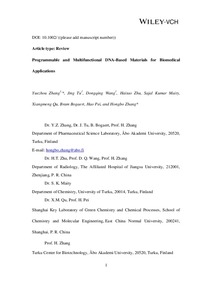Programmable and Multifunctional DNA-Based Materials for Biomedical Applications
Yuezhou Zhang; Jing Tu; Dongqing Wang; Haitao Zhu; Sajal Kumar Maity; Xiangmeng Qu; Bram Bogaert; Hao Pei; Hongbo Zhang
https://urn.fi/URN:NBN:fi-fe2021042718923
Tiivistelmä
DNA encodes the genetic information; recently, it has also become a key player in material science. Given the specific Watson–Crick base‐pairing interactions between only four types of nucleotides, well‐designed DNA self‐assembly can be programmable and predictable. Stem‐loops, sticky ends, Holliday junctions, DNA tiles, and lattices are typical motifs for forming DNA‐based structures. The oligonucleotides experience thermal annealing in a near‐neutral buffer containing a divalent cation (usually Mg2+) to produce a variety of DNA nanostructures. These structures not only show beautiful landscape, but can also be endowed with multifaceted functionalities. This Review begins with the fundamental characterization and evolutionary trajectory of DNA‐based artificial structures, but concentrates on their biomedical applications. The coverage spans from controlled drug delivery to high therapeutic profile and accurate diagnosis. A variety of DNA‐based materials, including aptamers, hydrogels, origamis, and tetrahedrons, are widely utilized in different biomedical fields. In addition, to achieve better performance and functionality, material hybridization is widely witnessed, and DNA nanostructure modification is also discussed. Although there are impressive advances and high expectations, the development of DNA‐based structures/technologies is still hindered by several commonly recognized challenges, such as nuclease instability, lack of pharmacokinetics data, and relatively high synthesis cost.
Kokoelmat
- Rinnakkaistallenteet [27094]
